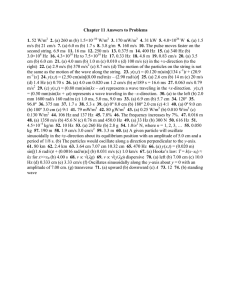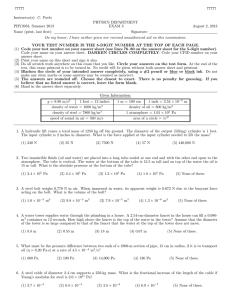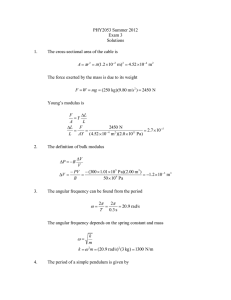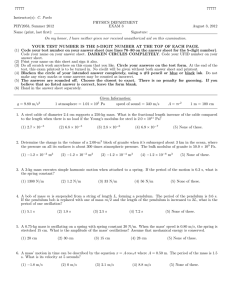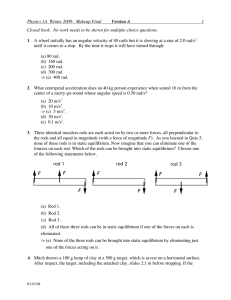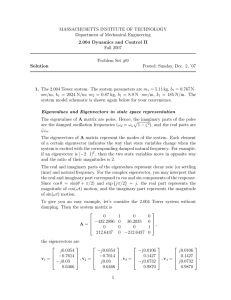PHY2053 Summer 2013 Exam 3 Solutions
advertisement
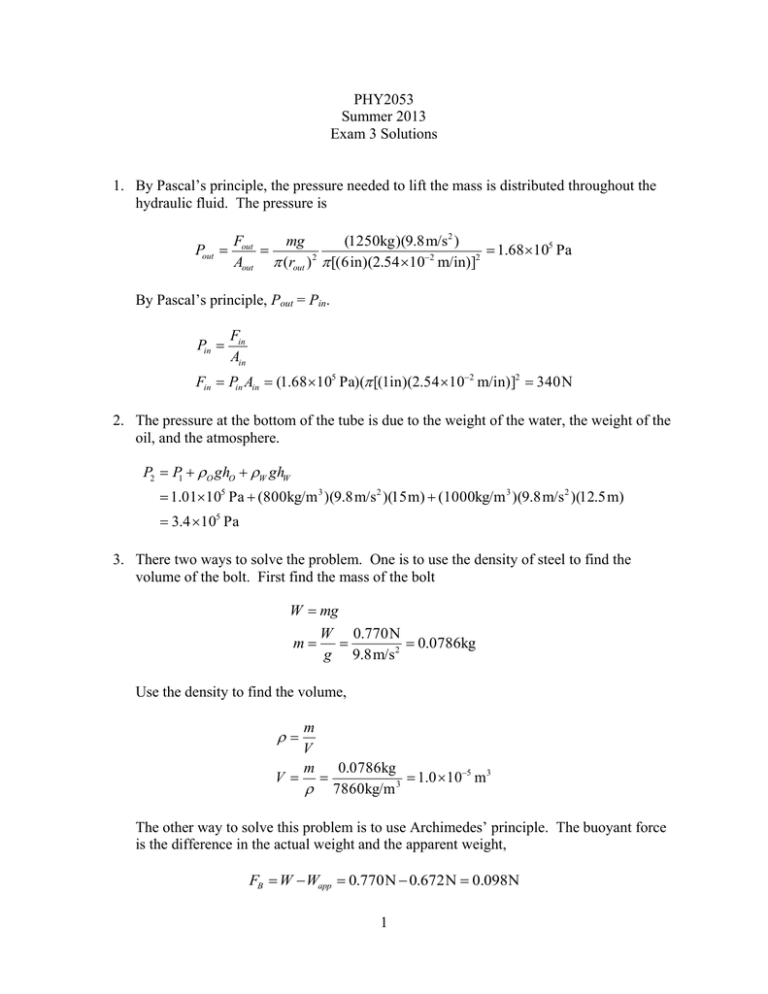
PHY2053 Summer 2013 Exam 3 Solutions 1. By Pascal’s principle, the pressure needed to lift the mass is distributed throughout the hydraulic fluid. The pressure is Pout Fout mg (1250kg )(9.8 m/s2 ) 1.68 105 Pa 2 2 2 Aout (rout ) [( 6 in)(2.54 10 m/in)] By Pascal’s principle, Pout = Pin. Pin Fin Ain Fin Pin Ain (1.68 105 Pa)( [(1in)(2.54 102 m/in)]2 340 N 2. The pressure at the bottom of the tube is due to the weight of the water, the weight of the oil, and the atmosphere. P2 P1 O ghO W ghW 1.01105 Pa (800kg/m 3 )(9.8 m/s2 )(15 m) (1000kg/m 3 )(9.8 m/s2 )(12.5 m) 3.4 105 Pa 3. There two ways to solve the problem. One is to use the density of steel to find the volume of the bolt. First find the mass of the bolt W mg W 0.770 N m 0.0786kg g 9.8 m/s2 Use the density to find the volume, V m V m 0.0786kg 1.0 105 m3 3 7860kg/m The other way to solve this problem is to use Archimedes’ principle. The buoyant force is the difference in the actual weight and the apparent weight, FB W Wapp 0.770 N 0.672 N 0.098N 1 Now use Archimedes’ principle FB gV V F 0.098 N 1.0 105 m 3 g (1000kg/m 3 )(9.8 m/s 2 ) 4. The volume flow rate is related to the speed of the water, V Av t 1 V 1 V 1 0.080 m3 v 2 13.2 m/s A t r t ((0.0254m) / 2) 2 12 s This velocity is created as the water flows from down from the tower. Using Bernoulli’s equation P1 gy1 12 v1 P2 gy2 12 v2 2 2 Associate the 1 subscript with the tower and the 2 subscript with the faucet. Since the tower and the faucet are open to the atmosphere, P1 = P2 = Patm. The tower has such a large volume and its level falls very slowly, v1 = 0. Patm gy1 12 (0) 2 Patm gy2 12 v2 2 g ( y1 y2 ) 12 v2 2 2 y1 y2 v2 (13.2 m/s)2 8.8 m 2 g 2(9.8 m/s 2 ) 5. Use Poiseuille’s law V P / L 4 r t 8 V 8 L 8 (1900m)(0.20 Pa s) P (4.5 104 m3 /s) 860 Pa 4 t r (0.15 cm) 4 6. The stress in the cable is stress F mg (250 kg )(9.8 m/s2 ) 2 5.42 106 Pa 2 A r (0.012 m) Young’s modulus is 2 stress strain stress 5.42 106 Pa strain 2.7 105 11 Y 2.0 10 Pa Y Since strain = L/L this is the fractional increase in length. 7. The volume compresses 0.10% = 0.001. The relationship defining the bulk modulus, P B V (90 109 Pa)(0.001) 9.0 107 Pa V 8. The spring constant is k mg (3 kg )(9.8 m/s2 ) 118 N/m x 0.25 m The period of a simple harmonic oscillator is m (3 kg ) 2 1.0 s k (118 N/m) T 2 9. The period of a pendulum is T 2 L g Forming a ratio TM TE L gM 2 L gE 2 gE gM gE 9.8 m/s 2 (2.0 s) 3.2 s gM 3.8 m/s 2 TM TE 10. Use the conservation of energy U1 K1 U 2 K 2 1 2 kA2 0 12 kx2 K 2 2 3 The amplitude is A = 0.25 cm. Solving for K2, K 2 12 kA2 12 kx2 12 k ( A2 x2 ) 12 (50 N/m)((0.25 m) 2 (0.10 m) 2 ) 1.3 J 2 2 11. Since vm = A, the amplitude can be found, vm A 4 m/s 0.667 m 6 rad/s The position function for the given velocity function is y Asint (0.667m) sin[(6 rad/s)(3s)] 0.50 m Your calculator must be in radian mode to get this result. 12. The intensity is a function of distance, I P 4r 2 Forming a ratio P 2 2 r1 I 2 4r2 P I1 r2 2 4r1 Solving for r2 I 2 r1 I1 r2 r1 r2 r2 r1 2 I2 I1 I1 0.1 W/m 2 (2 m) 6. 3 m I2 0.01W/m 2 13. The speed of a wave in string is 4 F v v2 F F v2 m F L v2 F 75 N m 2L (5 m) 0.019 kg v (140 m/s) 2 14. The velocity of the wave is related to the wavenumber and angular frequency v k vk (60 m/s)(3.0 rad/m) 180 rad/s The general equation of a wave traveling in the –x direction is y A cos(t kx) Substituting the values above, y A cos((180rad/s)t (3.0 rad/m) x) 15. Since the end of the rope is a free end, the reflected pulse will have the same orientation as the incident pulse. Both pulses will point upward when they meet and A A1 A2 (3 cm) (4 cm) 7 cm 16. The speed of the wave can be found v F mg (2.10 kg )(9.8 m/s2 ) 761m/s 3.55 105 kg/m For the lowest frequency, the wavelength is twice the length of the string, = 2L = 4 m. The frequency is f v 761m/s 190 Hz 4m 5 17. The decibel scale is defined as I I0 10 log Solving for I, I I 0 10 log I I0 / 10 log I 10 / 10 I0 I I 010 / 10 (1.0 1012 W/m2 )1070 / 10 1.0 105 W/m2 18. The frequencies for a pipe open at both ends is given by fn n v 2L where n = 1, 2, 3, etc. f1 1 v 340 m/s 170 Hz 2L 2(1m) The next frequency corresponds to n = 2 f1 2 v 340 m/s 340 Hz 2L 1m The frequencies are 170 Hz and 340 Hz. 19. Two waves with similar frequencies create beats. 20. The vehicles are traveling in different directions vs vo 6 The sound travels in the same direction as the sound. Therefore vs > 0. The car moves against the sound waves and vo < 0. Using the equation for the Doppler effect vo 1 v f0 f s v 1 s v (25 m/s) 1 340 m/s (550 Hz) 660 Hz 35 m/s 1 340 m/s 7
